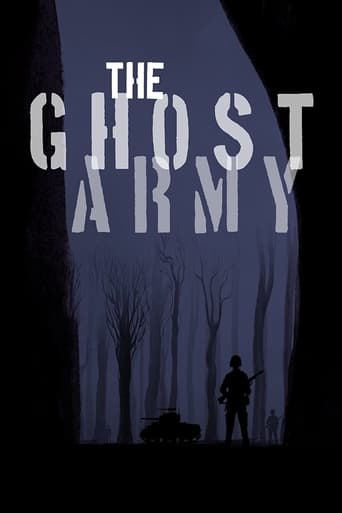Supelice
Dreadfully Boring
Comwayon
A Disappointing Continuation
Kinley
This movie feels like it was made purely to piss off people who want good shows
Edwin
The storyline feels a little thin and moth-eaten in parts but this sequel is plenty of fun.
matthijsalexander
How does one rate a documentary? How can this documentary not be a 10? if 10 is excellent.What a story, what a stroke of genius and, oddly, how awesome to learn that hippies, artists and such people that are generally opposed to war seem to have had a crucial part in it.The Ghost Army is a tale of deception and ingenuity, a must watch documentary!
peterbreis
Fascinating and shows what can be done with flair and imagination.The only thing that was lacking was due to the usual American self-obsession, their monocular view of themselves at the centre of the universe.There was a brief mention that the British had requested the unit but no mention of why or the background. That was because it was repeating what the British had done very successfully long before in North Africa against Rommel. Right down to the inflatable tanks, trucks, false railway tracks, airfields, radio broadcasts etc. Everything.It was the British who had the actual imaginative leaps that created deceptions like this, as well as "The Man Who Never Was", the incredibly subtle propaganda/psychology division that dropped false "Nazi" literature and "Nazi Propaganda" on German troops. It was also the British who created the "Funnies", weird contraptions that made their and the Canadian landings on D-Day so successful, whilst the Americans got themselves into immense trouble after having spurned the "crazy" ideas.This documentary would have been so much more complete and generous to all concerned, if it had shown the long running deceptions that had been going on the entire war, on all sides, not just when the Americans finally showed up and took the credit for winning a long grinding war already half over and largely won on the Eastern Front.None of this is to detract from what the The Ghost Army did, but contrary to what the film purports to show, they were not alone, they were not the first, and it was not even their idea.
Ric-7
I was reminded of Clooney's "The Monuments Men." As much as I liked Clooney's movie, I think these guys and their story would be ideal material for a film. The Monuments Men involved the plan to save priceless art, but Frankenheimer had already used that theme for The Train. On first impression, the camouflage brigade seems almost a parody of The Dirty Dozen. The idea of assembling a squad of specialists, drawn from professionals in the fine arts, is something new. A war movie featuring various artists, art directors and designers for film and theatre, recording engineers, not only to create camouflage but later to create decoys, plus it all being TRUE--how could such a film not make a mint? I totally loved this documentary, and I am very grateful that the recollections of many of the participants were recorded at last. It is a shame that their story was not told sooner.
runamokprods
Tremendously entertaining and off-beat documentary about a U.S. WWII corps largely made up of artists, designers, stage folk, and craftsmen, tasked with both improving camouflage, and creating the illusion of troops where they weren't. They used a combination of inflatable tanks and infantry pieces, along with broadcasting false orders by radio, and playing the sounds of an army unit over loudspeakers. They did a lot of good, while often taking on the nerve shattering task of trying to draw fire themselves, directing it away from the real battle units. There's a lot of humor here, unusual and appreciated for a WWII doc. But on the flip side, there's not a lot of emotion, and it can be a bit repetitive. An interesting true story of an oddball but important group of soldiers.

